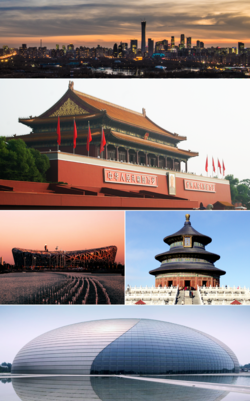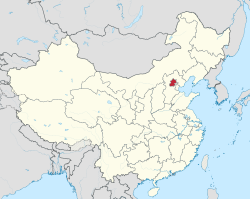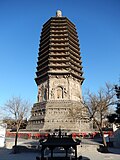Beijing
Beijing is the capital of the People's Republic of China. The city used to be known as Peking. It is in the northern and eastern parts of the country. Having more that 21 million residents, it is one of the most populous capital cities.
|
北京市 Peking | |
|---|---|
 | |
 Location of Beijing Municipality within China | |
| Coordinates: 39°55′N 116°23′E / 39.917°N 116.383°ECoordinates: 39°55′N 116°23′E / 39.917°N 116.383°E | |
| Country | People's Republic of China |
| Established | 1045 BC (Zhou Dynasty) |
| Divisions[1] – County-level – Township-level | 16 districts 289 towns and villages |
| Government | |
| • Type | Municipality |
| • Party Secretary | . |
| • Mayor | . |
| • Congress Chairman | Li Wei |
| • Conference Chairman | Ji Lin |
| Area | |
| • Municipality | 16,410.5 km2 (6,336.1 sq mi) |
| • Urban (2018)[3] | 4,144 km2 (1,600 sq mi) |
| • Rural | 12,266.5 km2 (4,736.1 sq mi) |
| Elevation | 43.5 m (142.7 ft) |
| Population (2018)[4] | |
| • Municipality | 21,542,000 |
| • Density | 1,312.70/km2 (3,399.87/sq mi) |
| • Urban (2018)[5] | 21,450,000 |
| • Metro (2017) | 24,000,000 |
| • Ranks in China | Population: 27th; Density: 4th |
| Major ethnic groups | |
| • Han | 95% |
| • Manchu | 2% |
| • Hui | 2% |
| • Mongol | 0.3% |
| • Other | 0.7% |
| Time zone | UTC+8 (CST) |
| ISO 3166 code | CN-BJ |
| GDP (nominal)[6] | 2018 |
| - Total | ¥3.03 trillion ($458 billion) (12th) |
| – Per capita | ¥140,748 ($21,261) (1st) |
| – Growth | |
| HDI (2017) | 0.888[7] (1st)—very high |
| License plate prefixes | 京A, C, E, F, H, J, K, L, M, N, P, Q, Y 京B (taxis) 京G (outside urban area) 京O, D (police and authorities) |
| Abbreviation | BJ / 京 (jīng) |
| City trees | Chinese arborvitae (Platycladus orientalis) |
| Pagoda tree (Sophora japonica) | |
| City flowers | China rose (Rosa chinensis) |
| Chrysanthemum (Chrysanthemum morifolium) | |
| Website | Beijing Official Website International – eBeijing.gov.cn (in English) 首都之窗-北京市政务门户网站 (in Chinese) |
| Beijing | |||||||||||||||||||||||||||||||||||
|---|---|---|---|---|---|---|---|---|---|---|---|---|---|---|---|---|---|---|---|---|---|---|---|---|---|---|---|---|---|---|---|---|---|---|---|

| |||||||||||||||||||||||||||||||||||
| "Běijīng" in regular Chinese characters | |||||||||||||||||||||||||||||||||||
| Chinese | 北京 | ||||||||||||||||||||||||||||||||||
| Hanyu Pinyin | |||||||||||||||||||||||||||||||||||
| Postal Map | Peking[8] Peiping (1368–1403; 1928–1937; 1945–1949) | ||||||||||||||||||||||||||||||||||
| Literal meaning | "Northern Capital" | ||||||||||||||||||||||||||||||||||
| |||||||||||||||||||||||||||||||||||
The city of Beijing has played a very important role in the development of China. Many people from different cities and countries come to Beijing to look for better chances to find work. Nearly 15 million people live there. Beijing hosted the Summer Olympic Games in 2008, and the Winter Olympic Games in 2022. It is the only city that has hosted both.
Beijing is well known for its ancient history. Since the Jin Dynasty, Beijing has been the capital of several dynasties (especially the later ones), including the Yuan, Ming, and Qing. There are many places of historic interest in Beijing.
Name
The Mandarin Chinese name of the city is Běijīng,[a] which means "The Northern Capital". It got this name when the Yongle Emperor of the Ming family of rulers moved most of his government from Nanjing ("The Southern Capital") in the early 1400s. In Chinese, Beijing's name is written Chinese: 北京. Today, people spell it "Beijing" because they use the pinyin way of spelling, which shows what the name should sound like in Mandarin. People used to spell it "Peking" because that was the spelling used by some of the first people from Europe to visit the Ming and write home about it; the Jesuits' work was made popular by their French brother Du Halde.[9] It then became the official Chinese Postal Map spelling around 1900 and continued to be used until pinyin became more popular.[10]
Beijing was also known as Beiping ("City of Northern Peace") between 1928 and 1949, when the Nationalists moved the Chinese capital to Nanjing and Chongqing.
History
The center of Beijing was settled in the 1st millennium BC. In those days, the Kingdom of Yan (燕, Yān) set up their capital where Beijing is today.[11] They called it Ji (蓟, Jì). After the Kingdom of Yan was destroyed, the city became smaller, although it was still an important place.
Beijing became more important again in the 10th century, when the Jin dynasty set its capital there. This city was destroyed by Mongol forces in 1215. Then in 1267, Mongols built a new city on the north side of the Jin capital, and called it "Great Capital" (大都, Dàdū), which was the beginning of modern Beijing. When Kublai Khan the Mongolian monarch, set up the Yuan dynasty, this city became his capital.
The Yuan Dynasty, Ming Dynasty and Qing dynasty all made Beijing their capital. When the Qing dynasty lost power and the Republic of China was set up, the new Republic moved its capital from Beijing to Nanjing. When the People's Republic of China seized power, Beijing became the capital of China again.
In 1989, there were protests in Tian'anmen Square because some people wanted democracy.[11]
Throughout its history, Beijing was the Chinese capital six times:[12]
- 221 BC: Yan State capital
- 1271: Yuan Dynasty national capital
- 1402: Ming Dynasty capital
- 1644: Qing Dynasty capital
- 1912: Republic of China capital
- 1949: People's Republic of China capital
Special places
Important places in Beijing include:
- The Great Wall of China (Chángchéng), in the mountains between Beijing and the grasslands of Mongolia
- The Forbidden City (Gùgōng), the most important home of the emperors of Ming and Qing China
- Tian'anmen Square (Tiān'ānmén Guǎngchǎng), surrounded by China's most important government buildings and museums
- Jingshan & Beihai Parks, the hill overlooking the Forbidden City and the lake beside it, with many temples
- The Summer Palace (Yìhéyuán) and Old Summer Palace (Yuánmíng Yuán), the more natural home of the last Qing emperors and what is left of an older one
- Prince Gong's Mansion, a very nice old house for one of the Qing princes
- The Imperial Ancestral Temple (Tàimiào), where the emperors remembered the earlier people in their families
- The Temple of Heaven (Tiāntán) and Temple of the Earth (Dìtán), important places for China's old national religion
- The Temples of the Sun and the Moon, other important places for China's old national religion
- The Temple of Confucius and Imperial Academy, important places for China's old kind of education
- Niujie Mosque, a place for Beijing's Muslims and one of the city's oldest buildings
- The National and Urban Planning Museums
- Olympic Green, the park left from the 2008 Beijing Olympics
- Marco Polo Bridge, a very old bridge across the main river west of town
- Ming Tombs, where many Ming emperors were buried
- Zhoukoudian, caves in the mountains west of town where people lived long, long ago
Education
Beijing is the education center of People's Republic of China. More than 500 famous universities of China are in Beijing. They also include 5 of the top universities: Peking University, Tsinghua University, China People University, Beijing Normal University, and Beihang University. Beijing is also education center of China for teaching Chinese as a foreign language. The standard Chinese pronunciation is based on Beijing dialect, so over 70% foreigners who want to study Chinese go to Beijing for their studies.
- Beijing
Beijing Media
Summer Palace, one of several palatial gardens built by Qing emperors in the northwest suburb area
A large portrait of Chiang Kai-shek was displayed above Tiananmen after World War II.
Tiananmen during People's Republic of China
Sources
Pages
- ↑ "Township divisions". the Official Website of tGovernment. Archived from the original on 3 September 2009. Retrieved 22 July 2009.
- ↑ "Doing Business in China – Survey". Ministry Of Commerce – People's Republic Of China. Archived from the original on 26 May 2014. Retrieved 5 August 2013.
- ↑ Cox, W (2018). Demographia World Urban Areas. 14th Annual Edition (PDF). St. Louis: Demographia. p. 22. Archived from the original (PDF) on 3 May 2018. Retrieved 15 June 2018.
- ↑ "Beijing Municipal Bureau of Statistics and NBS Survey Office in Beijing". Beijing Bureau of Statistics. 23 January 2019. Archived from the original on 23 January 2019. Retrieved 24 January 2019.
- ↑ Cox, W (2018). Demographia World Urban Areas. 14th Annual Edition (PDF). St. Louis: Demographia. p. 22. Retrieved 15 June 2018.
- ↑ "2018年北京经济总体平稳 稳中提质" 北京市2018年国民经济和社会发展统计公报 [Statistical Communiqué of Beijing on the 2018 National Economic and Social Development] (in 中文). Statistical Bureau of Beijing. 23 January 2019. Archived from the original on 23 January 2019. Retrieved 24 January 2019.
- ↑ "Subnational Human Development Index" (in 中文). United Nations Development Programme China. 2017. Archived from the original on 23 September 2018. Retrieved 27 October 2018.
- ↑ Loaned earlier via French "Pékin".
- ↑ Du Halde (1735), Vol. I, p. 135.
- ↑ Harris (2008), p. 99.
- ↑ 11.0 11.1 "History - Beijing". Retrieved 23 July 2014.
- ↑ "10 Incredible Facts About Beijing, China". China Admissions. Retrieved 20 July 2024.
- ↑ These marks show the tones of the Chinese word, which are important in saying them correctly.
Books
- Du Halde, Jean-Baptiste (1735), Description... de l'Empire de la Chine et de la Tartarie Chinoise, Paris: P.G. Lemercier. (in French)
- Harris, Lane J. (November 2008), "A 'Lasting Boon to All': A Note on the Postal Romanization of Place Names, 1896–1949", Twentieth-Century China, vol. 34, No. 1, Baltimore, pp. 96–109, doi:10.1353/tcc.0.0007, ISSN 1521-5385, S2CID 68653154.
Other websites
| Wikimedia Commons has media related to Lua error in Module:Commons_link at line 62: attempt to index field 'wikibase' (a nil value).. |
- Beijing Travel Archived 2009-03-07 at the Wayback Machine
- Beijing Travel Guide
- Voyage Pékin Archived 2009-05-17 at the Wayback Machine
- Photos of Beijing Archived 2013-02-16 at the Wayback Machine
















